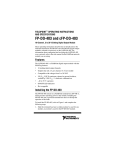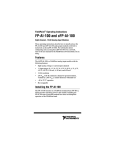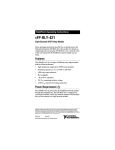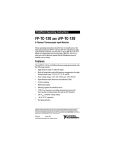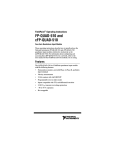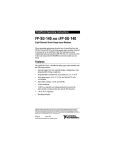Download National Instruments cFP-Al-110 Music Mixer User Manual
Transcript
FieldPoint™ Operating Instructions FP-AI-110 and cFP-AI-110 Eight-Channel, 16-Bit Analog Input Modules These operating instructions describe how to install and use the FP-AI-110 and cFP-AI-110 analog input modules (referred to inclusively as the [c]FP-AI-110). For information about configuring and accessing the [c]FP-AI-110 over a network, refer to the user manual for the FieldPoint network module you are using. Features The [c]FP-AI-110 is a FieldPoint analog input module with the following features: • Eight analog voltage or current input channels • Eight voltage input ranges: 0–1 V, 0–5 V, 0–10 V, ±60 mV, ±300 mV, ±1 V, ±5 V, and ±10 V • Three current input ranges: 0–20, 4–20, and ±20 mA • 16-bit resolution • Three filter settings: 50, 60, and 500 Hz • 250 Vrms CAT II continuous channel-to-ground isolation, verified by 2,300 Vrms dielectric withstand test • –40 to 70 °C operation • Hot swappable Installing the FP-AI-110 The FP-AI-110 mounts on a FieldPoint terminal base (FP-TB-x), which provides operating power to the module. Installing the FP-AI-110 onto a powered terminal base does not disrupt the operation of the FieldPoint bank. To install the FP-AI-110, refer to Figure 1 and complete the following steps: 1. Slide the terminal base key to either position X (used for any module) or position 1 (used for the FP-AI-110). 2. Align the FP-AI-110 alignment slots with the guide rails on the terminal base. 3. Press firmly to seat the FP-AI-110 on the terminal base. When the FP-AI-110 is firmly seated, the latch on the terminal base locks it into place. 4 5 3 6 1 1 2 3 2 I/O Module Terminal Base Alignment Slot 4 5 6 Key Latch Guide Rails Figure 1. Installing the FP-AI-110 Installing the cFP-AI-110 The cFP-AI-110 mounts on a Compact FieldPoint backplane (cFP-BP-x), which provides operating power to the module. Installing the cFP-AI-110 onto a powered backplane does not disrupt the operation of the FieldPoint bank. To install the cFP-AI-110, refer to Figure 2 and complete the following steps: 1. Align the captive screws on the cFP-AI-110 with the holes on the backplane. The alignment keys on the cFP-AI-110 prevent backward insertion. 2. Press firmly to seat the cFP-AI-110 on the backplane. 3. Using a number 2 Phillips screwdriver with a shank of at least 64 mm (2.5 in.) length, tighten the captive screws to 1.1 N ⋅ m FP-AI-110 and cFP-AI-110 2 ni.com (10 lb ⋅ in.) of torque. The nylon coating on the screws prevents them from loosening. 4 3 5 2 4 2 1 1 2 3 cFP-DI-300 Captive Screws cFP Controller Module 4 5 Screw Holes cFP Backplane Figure 2. Installing the cFP-AI-110 Wiring the [c]FP-AI-110 The FP-TB-x terminal base has connections for each of the eight input channels and for an external power supply to power field devices. The cFP-CB-x connector block provides the same connections. Each channel has separate input terminals for voltage (VIN) and current (IIN) input. Voltage and current inputs are referenced to the COM terminals, which are internally connected to each other and to the C terminals. All eight VSUP terminals are internally connected to each other and to the V terminals. You can use a 10–30 VDC external supply to power field devices. Connect the external power supply to multiple V and VSUP terminals so that the maximum current through any V terminal © National Instruments Corp. 3 FP-AI-110 and cFP-AI-110 is 2 A or less and the maximum current through any VSUP terminal is 1 A or less. Install a 2 A maximum, fast-acting fuse between the external power supply and the V terminal on each channel. The wiring diagrams in this document show fuses where appropriate. Table 1 lists the terminal assignments for the signals associated with each channel. The terminal assignments are the same for the FP-TB-x terminal bases and the cFP-CB-x connector blocks. Table 1. Terminal Assignments Terminal Numbers IIN2 VSUP3 COM 1 2 17 18 1 3 4 19 20 2 5 6 21 22 3 7 8 23 24 4 9 10 25 26 5 11 12 27 28 6 13 14 29 30 7 15 16 31 32 Channel VIN 0 1 1 Install a 2 A, fast-acting fuse on each VIN terminal. 2 Install a 2 A, fast-acting fuse on each I terminal. IN 3 Install a 2 A maximum, fast-acting fuse on each V SUP terminal. Do not connect both current and voltage inputs to the same channel. Caution Cascading power between two modules defeats isolation between those modules. Cascading power from the network module defeats all isolation between modules in the FieldPoint bank. Caution FP-AI-110 and cFP-AI-110 4 ni.com Taking Measurements with the [c]FP-AI-110 The [c]FP-AI-110 has eight single-ended input channels. All eight channels share a common ground reference that is isolated from other modules in the FieldPoint system. Figure 3 shows the analog input circuitry on one channel. V VSUP VIN IIN Filter 16-Bit Isolated ADC Filter COM C Figure 3. FP-AI-110 Analog Input Circuit Measuring Voltage with the [c]FP-AI-110 The input ranges for voltage signals are 0–1 V, 0–5 V, 0–10 V, ±60 mV, ±300 mV, ±1 V, ±5 V, and ±10 V. Figure 4 shows how to connect a voltage source without an external power supply to one channel of the [c]FP-AI-110. C V VSUP To Analog Input Circuitry VIN Voltage Source + – >100 MΩ Input Impedance IIN COM To Next Channel [c]FP-AI-110 Figure 4. Voltage Source without External Power Supply © National Instruments Corp. 5 FP-AI-110 and cFP-AI-110 Figure 5 shows how to connect a voltage source with an external power supply to one channel of the [c]FP-AI-110. 1A Max Powered + Voltage OUT Transducer – 10–30 VDC + External Power Supply – (Optional) 2A Max C V VSUP To Analog Input Circuitry VIN IIN COM To Next Channel [c]FP-AI-110 Figure 5. Voltage Source with External Power Supply Measuring Current with the [c]FP-AI-110 The input ranges for current sources are 0–20, 4–20, and ±20 mA. The module reads current flowing into the IIN terminal as positive and current flowing out of the terminal as negative. Current flows into the IIN terminal, goes through a 100 Ω resistor, and flows out from the COM or C terminal. Figure 6 shows how to connect a current source without an external power supply to one channel of the [c]FP-AI-110. FP-AI-110 and cFP-AI-110 6 ni.com C V VSUP VIN 1A Max Current Source To Analog Input Circuitry IIN COM To Next Channel [c]FP-AI-110 Figure 6. Current Source without External Power Supply Figure 7 shows how to connect a current source with an external power supply to one channel of the [c]FP-AI-110. 1A Max Loop-Powered Current Transducer 10–30 VDC + External Power Supply – (Optional) 2A Max C V VSUP VIN To Analog Input Circuitry IIN COM To Next Channel [c]FP-AI-110 Figure 7. Current Source with External Power Supply Input Ranges To prevent inaccurate readings, choose an input range such that the signal you are measuring does not exceed either end of the range. © National Instruments Corp. 7 FP-AI-110 and cFP-AI-110 Overranging The [c]FP-AI-110 has an overranging feature that measures a little beyond the nominal values of each range. For example, the actual measurement limit of the ±10 V range is ±10.4 V. The overranging feature enables the [c]FP-AI-110 to compensate for field devices with span errors of up to +4% of full scale. Also, with the overranging feature, a noisy signal near full scale does not create rectification errors. Filter Settings Three filter settings are available for each channel. The filters on the [c]FP-AI-110 input channels are comb filters that provide notches of rejection at multiples, or harmonics, of a fundamental frequency. You can select a fundamental frequency of 50, 60, or 500 Hz. The [c]FP-AI-110 applies 95 dB of rejection at the fundamental frequency and at least 60 dB of rejection at each of the harmonics. In many cases, most of the noise components of input signals are related to the local AC power line frequency, so a filter setting of either 50 or 60 Hz is best. The filter setting determines the rate at which the [c]FP-AI-110 samples the inputs. The [c]FP-AI-110 resamples all of the channels at the same rate. If you set all of the channels to the 50 or 60 Hz filter, the [c]FP-AI-110 samples each channel every 1.470 s or every 1.230 s, respectively. If you set all of the channels to 500 Hz filters, the module samples each channel every 0.173 s. When you select different filter settings for different channels, use the following formula to determine the sampling rate. (number of channels with 50 Hz filter) ×184 ms + (number of channels with 60 Hz filter) ×154 ms + (number of channels with 500 Hz filter) × 21.6 ms = Update Rate If you are not using some of the [c]FP-AI-110 channels, set them to the 500 Hz filter setting to improve the response time of the module. For example, if one channel is set for a 60 Hz filter, and the other seven channels are set to 500 Hz, the module samples each channel every 0.3 s (four times faster than the case in which all eight channels are set to the 60 Hz setting). The sampling rate does not affect the rate at which the network module reads the data. The [c]FP-AI-110 always has data available for the network module to read; the sampling rate is the rate at which this data is updated. Set up your application so that the FP-AI-110 and cFP-AI-110 8 ni.com sampling rate is faster than the rate at which the network module polls the [c]FP-AI-110 for data. Status Indicators The [c]FP-AI-110 has two green status LEDs, POWER and READY. After you insert the [c]FP-AI-110 into a terminal base or backplane and apply power to the connected network module, the green POWER LED lights and the [c]FP-AI-110 informs the network module of its presence. When the network module recognizes the [c]FP-AI-110, it sends initial configuration information to the [c]FP-AI-110. After the [c]FP-AI-110 receives this initial information, the green READY LED lights and the module is in normal operating mode. A blinking or unlit READY LED indicates an error condition. Upgrading the FieldPoint Firmware You may need to upgrade the FieldPoint firmware when you add new I/O modules to the FieldPoint system. For information on determining which firmware you need and how to upgrade your firmware, go to ni.com/info and enter fpmatrix. Isolation and Safety Guidelines Read the following information before attempting to connect the [c]FP-AI-110 to any circuits that may contain hazardous voltages.1 Caution This section describes the isolation of the [c]FP-AI-110 and its compliance with international safety standards. The field wiring connections are isolated from the backplane and the inter-module communication bus. The isolation barriers in the module provide 250 Vrms Measurement Category II continuous channel-to-backplane and channel-to-ground isolation, verified by 2,300 Vrms , 5 s dielectric withstand test.2 The [c]FP-AI-110 provides double insulation (compliant with IEC 61010-1) for 1 A hazardous voltage is a voltage greater than 42.4 Vpeak or 60 VDC. When a hazardous voltage is present on any channel, all of the channels must be considered to be carrying hazardous voltages. Ensure that all circuits connected to the module are inaccessible to human touch. 2 Refer to the Safety Isolation Voltage section for more information about isolation on the [c]FP-AI-110. © National Instruments Corp. 9 FP-AI-110 and cFP-AI-110 working voltages of 250 Vrms1. Safety standards (such as those published by UL and IEC) require the use of double insulation between hazardous voltages and any human-accessible parts or circuits. Never try to use any isolation product between human-accessible parts (such as DIN rails or monitoring stations) and circuits that can be at hazardous potentials under normal conditions, unless the product is specifically designed for such an application, as is the [c]FP-AI-110. Even though the [c]FP-AI-110 is designed to handle applications with hazardous potentials, follow these guidelines to ensure a safe total system: • There is no isolation between channels on the [c]FP-AI-110. If a hazardous voltage is present on any channel, all channels are considered hazardous. Make sure that all other devices and circuits connected to the module are properly insulated from human contact. • Do not share the external supply voltages (the V and C terminals) with other devices (including other FieldPoint devices), unless those devices are isolated from human contact. • For Compact FieldPoint, you must connect the protective earth (PE) ground terminal on the cFP-BP-x backplane to the system safety ground. The backplane PE ground terminal has the following symbol stamped beside it: . Connect the backplane PE ground terminal to the system safety ground using 14 AWG (1.6 mm) wire with a ring lug. Use the 5/16 in. panhead screw shipped with the backplane to secure the ring lug to the backplane PE ground terminal. • As with any hazardous voltage wiring, make sure that all wiring and connections meet applicable electrical codes and commonsense practices. Mount terminal bases and backplanes in an area, position, or cabinet that prevents accidental or unauthorized access to wiring that carries hazardous voltages. • Do not use the [c]FP-AI-110 as the only isolating barrier between human contact and working voltages higher than 250 Vrms . 1 Working voltage is defined as the signal voltage plus the common-mode voltage. Common-mode voltage is the voltage of the module with respect to ground. FP-AI-110 and cFP-AI-110 10 ni.com • Operate the [c]FP-AI-110 only at or below Pollution Degree 2. Pollution Degree 2 means that only nonconductive pollution occurs in most cases. Occasionally, however, a temporary conductivity caused by condensation must be expected. • Operate the [c]FP-AI-110 at or below Measurement Category II. Measurement Category II is for measurements performed on circuits directly connected to the low-voltage installation. This category refers to local-level distribution, such as that provided by a standard wall outlet. Safety Guidelines for Hazardous Locations The [c]FP-AI-110 is suitable for use in Class I, Division 2, Groups A, B, C, and D hazardous locations; Class 1, Zone 2, AEx nC IIC T4 and Ex nC IIC T4 hazardous locations; and nonhazardous locations only. Follow these guidelines if you are installing the [c]FP-AI-110 in a potentially explosive environment. Failing to follow these guidelines may result in serious injury or death. Caution Do not disconnect I/O-side wires or connectors unless power has been switched off or the area is known to be nonhazardous. Caution Do not remove modules unless power has been switched off or the area is known to be nonhazardous. Substitution of components may impair suitability for Class I, Division 2. Caution For Zone 2 applications, install the Compact FieldPoint system in an enclosure rated to at least IP 54 as defined by IEC 60529 and EN 60529. Caution Special Conditions for Safe Use in Europe This equipment has been evaluated as EEx nC IIC T4 equipment under DEMKO Certificate No. 03 ATEX 0251502X. Each module is marked II 3G and is suitable for use in Zone 2 hazardous locations. For Zone 2 applications, connected signals must be within the following limits: Caution Capacitance .......................... 20 µF max Inductance ............................ 0.2 H max © National Instruments Corp. 11 FP-AI-110 and cFP-AI-110 Safety Guidelines for Hazardous Voltages If hazardous voltages are connected to the module, take the following precautions. A hazardous voltage is a voltage greater than 42.4 Vpeak or 60 VDC to earth ground. Ensure that hazardous voltage wiring is performed only by qualified personnel adhering to local electrical standards. Caution Caution Do not mix hazardous voltage circuits and human-accessible circuits on the same module. Make sure that devices and circuits connected to the module are properly insulated from human contact. Caution When terminals on the connector block are live with hazardous voltages, make sure that the terminals are not accessible. Caution Specifications The following specifications are typical for the range –40 to 70 °C unless otherwise noted. Gain errors are given as a percentage of input signal value. Specifications are subject to change without notice. Input Characteristics Number of channels.......................... 8 ADC resolution................................. 16 bits at 50 or 60 Hz; 10 bits at 500 Hz Type of ADC..................................... Delta-sigma FP-AI-110 and cFP-AI-110 12 ni.com Effective resolution by input signal range and filter setting Nominal Input Range With Overranging Effective Resolution with 50 or 60 Hz Filter Enabled* Effective Resolution with 500 Hz or No Filter Enabled* Voltage ±60 mV ±300 mV ±1 V ±5 V ±10 V 0–1 V 0–5 V 0–10 V ±65 mV ±325 mV ±1.04 V ±5.2 V ±10.4 V 0–1.04 V 0–5.2 V 0–10.4 V 3 µV 16 µV 40 µV 190 µV 380 µV 20 µV 95 µV 190 µV 25 µV 100 µV 300 µV 1,500 µV 3,000 µV 300 µV 1,500 µV 3,000 µV Current 0–20 mA 4–20 mA ±20 mA 0–21 mA 3.5–21 mA ±21 mA 0.5 µA 0.5 µA 0.7 µA 15 µA 15 µA 16 µA * Includes quantization errors and rms noise. Input characteristics by filter setting Filter Settings Characteristic 50 Hz 60 Hz 500 Hz rate* 1.470 s 1.230 s 0.173 s Effective resolution 16 bits 16 bits 10 bits Input bandwidth (–3 dB) 13 Hz 16 Hz 130 Hz Update * Applies when all eight channels are set to the same filter setting. Normal-mode rejection..................... 95 dB (with 50/60 Hz filter) Nonlinearity ...................................... 0.0015% (monotonicity1 guaranteed over the operating temperature range) Voltage Inputs Input impedance................................ >100 MΩ Overvoltage protection ..................... ±40 V 1 A characteristic of an ADC in which the digital code output always increases as the value of the analog input to it increases. © National Instruments Corp. 13 FP-AI-110 and cFP-AI-110 Input current 25 °C........................................... 400 pA typ, 1 nA max 70 °C........................................... 3 nA typ, 15 nA max Input noise (with 50 or 60 Hz filter enabled) ±60 mV range............................. ±3 LSB1 peak-to-peak ±300 mV range........................... ±2 LSB peak-to-peak Other ranges ............................... ±1 LSB peak-to-peak Typical and warranted accuracy by input range and temperature range 1 Nominal Input Range Typical Accuracy at 15 to 35 °C (% of Reading; % of Full Scale) Warranted Accuracy at 15 to 35 °C (% of Reading; % of Full Scale) ±60 mV ±0.04%; ±0.05% ±0.05%; ±0.3% ±300 mV ±0.04%; ±0.015% ±0.06%; ±0.1% ±1 V ±0.04%; ±0.008% ±0.05%; ±0.04% ±5 V ±0.04%; ±0.005% ±0.06%; ±0.02% ±10 V ±0.04%; ±0.005% ±0.06%; ±0.02% 0–1 V ±0.04%; ±0.005% ±0.05%; ±0.03% 0–5 V ±0.04%; ±0.003% ±0.06%; ±0.01% 0–10 V ±0.04%; ±0.003% ±0.06%; ±0.01% Nominal Input Range Typical Accuracy at –40 to 70 °C (% of Reading; % of Full Scale) Warranted Accuracy at –40 to 70 °C (% of Reading; % of Full Scale) ±60 mV ±0.06%; ±0.35% ±0.10%; ±1.5% ±300 mV ±0.07%; ±0.08% ±0.11%; ±0.40% ±1 V ±0.06%; ±0.03% ±0.10%; ±0.13% ±5 V ±0.07%; ±0.01% ±0.11%; ±0.04% ±10 V ±0.07%; ±0.01% ±0.11%; ±0.03% Least significant bit: the smallest voltage change detectable by the ADC. FP-AI-110 and cFP-AI-110 14 ni.com Nominal Input Range Typical Accuracy at –40 to 70 °C (% of Reading; % of Full Scale) Warranted Accuracy at –40 to 70 °C (% of Reading; % of Full Scale) 0–1 V ±0.06%; ±0.025% ±0.10%; ±0.12% 0–5 V ±0.07%; ±0.007% ±0.11%; ±0.03% 0–10 V ±0.07%; ±0.005% ±0.11%; ±0.02% Note Full scale is the maximum value of the nominal input range. For example, for the ±10 V input range, full scale is 10 V and ±0.01% of full scale is 1 mV. Gain error drift.................................. ±20 ppm/°C Offset error drift With 50 or 60 Hz filter enabled............................... ±6 µV/°C With 500 Hz filter enabled ......... ±15 µV/°C Current Inputs Input impedance................................ 60–150 Ω Overvoltage protection ..................... ±25 V Input noise (50 or 60 Hz filter) ......... 0.3 µA rms Typical and warranted accuracy by temperature range Typical Accuracy at 15 to 35 °C (% of Reading; % of Full Scale) Warranted Accuracy at 15 to 35 °C (% of Reading; % of Full Scale) ±0.08%; ±0.010% ±0.11%; ±0.012% Typical Accuracy at –40 to 70 °C (% of Reading; % of Full Scale) Warranted Accuracy at –40 to 70 °C (% of Reading; % of Full Scale) ±0.16%; ±0.016% ±0.3%; ±0.048% Offset error drift................................ ±100 nA/°C Gain error drift.................................. ±40 ppm/°C © National Instruments Corp. 15 FP-AI-110 and cFP-AI-110 Physical Characteristics Indicators .......................................... Green POWER and READY indicators Weight FP-AI-110................................... 140 g (4.8 oz) cFP-AI-110................................. 110 g (3.7 oz) Power Requirements Power from network module ............ 350 mW Safety Isolation Voltage Channel-to-ground isolation Continuous ................................. 250 Vrms, Measurement Category II Dielectric withstand.................... 2,300 Vrms (test duration is 5 s) Channel-to-channel isolation ............ No isolation between channels Environmental FieldPoint modules are intended for indoor use only. For outdoor use, they must be mounted inside a sealed enclosure. Operating temperature ...................... –40 to 70 °C Storage temperature .......................... –55 to 85 °C Humidity ........................................... 10 to 90% RH, noncondensing Maximum altitude............................. 2,000 m; at higher altitudes the isolation voltage ratings must be lowered. Pollution Degree ............................... 2 Shock and Vibration These specifications apply only to the cFP-AI-110. NI recommends Compact FieldPoint if your application is subject to shock and vibration. Operating vibration, random (IEC 60068-2-64).............................. 10–500 Hz, 5 grms Operating vibration, sinusoidal (IEC 60068-2-6)................................ 10–500 Hz, 5 g FP-AI-110 and cFP-AI-110 16 ni.com Operating shock (IEC 60068-2-27).............................. 50 g, 3 ms half sine, 18 shocks at 6 orientations; 30 g, 11 ms half sine, 18 shocks at 6 orientations Safety This product is designed to meet the requirements of the following standards of safety for electrical equipment for measurement, control, and laboratory use: • IEC 61010-1, EN 61010-1 • UL 61010-1 • CAN/CSA-C22.2 No. 61010-1 For UL, hazardous location, and other safety certifications, refer to the product label or visit ni.com/certification, search by model number or product line, and click the appropriate link in the Certification column. Electromagnetic Compatibility Emissions.......................................... EN 55011 Class A at 10 m FCC Part 15A above 1 GHz Immunity........................................... EN 61326:1997 + A2:2001, Table 1 CE, C-Tick, and FCC Part 15 (Class A) Compliant Note For EMC compliance, you must operate this device with shielded cabling. © National Instruments Corp. 17 FP-AI-110 and cFP-AI-110 CE Compliance This product meets the essential requirements of applicable European Directives, as amended for CE marking, as follows: Low-Voltage Directive (safety)......... 73/23/EEC Electromagnetic Compatibility Directive (EMC) ............................... 89/336/EEC Note Refer to the Declaration of Conformity (DoC) for this product for any additional regulatory compliance information. To obtain the DoC for this product, visit ni.com/certification, search by model number or product line, and click the appropriate link in the Certification column. Mechanical Dimensions Figure 8 shows the mechanical dimensions of the FP-AI-110 installed on a terminal base. If you are using the cFP-AI-110, refer to the Compact FieldPoint controller user manual for the dimensions and cabling clearance requirements of the Compact FieldPoint system. 107.19 [4.22] 109.5 [4.31] 91.44 [3.60] Figure 8. FP-AI-110 Mechanical Dimensions FP-AI-110 and cFP-AI-110 18 ni.com Where to Go for Support For more information about setting up the FieldPoint system, refer to these National Instruments documents: • FieldPoint network module user manual • Other FieldPoint I/O module operating instructions • FieldPoint terminal base and connector block operating instructions Go to ni.com/support for the most current manuals, examples, and troubleshooting information. National Instruments corporate headquarters is located at 11500 North Mopac Expressway, Austin, Texas, 78759-3504. National Instruments also has offices located around the world to help address your support needs. For telephone support in the United States, create your service request at ni.com/support and follow the calling instructions or dial 512 795 8248. For telephone support outside the United States, contact your local branch office: Australia 1800 300 800, Austria 43 0 662 45 79 90 0, Belgium 32 0 2 757 00 20, Brazil 55 11 3262 3599, Canada 800 433 3488, China 86 21 6555 7838, Czech Republic 420 224 235 774, Denmark 45 45 76 26 00, Finland 385 0 9 725 725 11, France 33 0 1 48 14 24 24, Germany 49 0 89 741 31 30, India 91 80 51190000, Israel 972 0 3 6393737, Italy 39 02 413091, Japan 81 3 5472 2970, Korea 82 02 3451 3400, Lebanon 961 0 1 33 28 28, Malaysia 1800 887710, Mexico 01 800 010 0793, Netherlands 31 0 348 433 466, New Zealand 0800 553 322, Norway 47 0 66 90 76 60, Poland 48 22 3390150, Portugal 351 210 311 210, Russia 7 095 783 68 51, Singapore 1800 226 5886, Slovenia 386 3 425 4200, South Africa 27 0 11 805 8197, Spain 34 91 640 0085, Sweden 46 0 8 587 895 00, Switzerland 41 56 200 51 51, Taiwan 886 02 2377 2222, Thailand 662 278 6777, United Kingdom 44 0 1635 523545 © National Instruments Corp. 19 FP-AI-110 and cFP-AI-110 National Instruments, NI, ni.com, and LabVIEW are trademarks of National Instruments Corporation. Refer to the Terms of Use section on ni.com/legal for more information about National Instruments trademarks. Other product and company names mentioned herein are trademarks or trade names of their respective companies. For patents covering National Instruments products, refer to the appropriate location: Help»Patents in your software, the patents.txt file on your CD, or ni.com/patents. © 2003–2005 National Instruments Corp. All rights reserved. 373280A-01 Jun05




















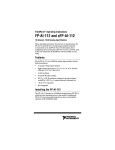
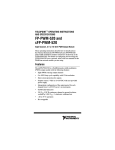
![[c]FP-DO-401 Operating Instructions](http://vs1.manualzilla.com/store/data/005693758_1-4b10a2df6965457ee651014d1377996a-150x150.png)
